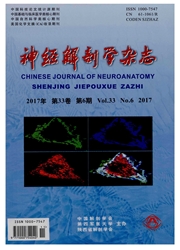

 中文摘要:
中文摘要:
目的:探讨硫代乙酰胺(rrAA)致肝性脑病(HE)小鼠肝脏和脑功能变化,寻找TAA的合适剂量和理想的观察指标。方法:设立4个TAA剂量组,分别以200、250、300、400mg/(kg·d)剂量的TAA隔24h行腹腔注射,共3次,建立不同剂量TAA致小鼠HE的动物模型,正常对照组腹腔注射生理盐水,每隔24h观察各组生存率变化,第4d进行脑功能评分、旷场实验和高架十字实验,第5d后观察其血氨和肝功指标。结果:(1)不同剂量的TAA致小鼠存活率差异,400mg/(kg·d)致小鼠存活率过低(31.6%);(2)不同剂量TAA致小鼠脑功能评分、旷场实验的总路程和中央活动时间、高架十字实验的开臂滞留时间百分比显著低于对照组(P〈0.05),但开臂进入次数百分比与对照组无显著差异(P〉0.05);(3)不同剂量TAA致小鼠血氨、AST和ALT水平显著低于对照组(P〈0.001),且不同剂量组之间存在显著差异(P〈0.001)。结论:(1)300mg/(kg·d)剂量TAA隔日腹腔注射3次为诱导小鼠A型HE模型的适宜剂量和方法;(2)TAA诱导A型HE小鼠脑功能异常,伴有自发活动减少和焦虑情绪,脑功能评分、旷场实验和高架十字实验可用于评估脑功能的变化;(3)TAA致肝功能变化呈现剂量依赖性,血氨、AST和ALT可用于评估肝功能的变化。
 英文摘要:
英文摘要:
Objective: To investigate the alternation of liver and brain function in mice with hepatic encephalopathy, and the appropriate dose of thioacetamide (TAA) to induce the animal model, and to choose reliable parameters for observation. Methods: Animal models of hepatic encephalopathy in C57BL/6 mice were induced by three times intraperitoneal injections of TAA 200, 250, 300, 400 mg/( kg. d) of body weight respectively at 24 hours intervals. Control mice received sterile normal saline solution at the same time. Survival was evaluated per 24 hours after the first injection of TAA. The neurological score, motor activities and anxiety were evaluated on day 4. Serum ammonia, aspartate aminotransferase (AST) and alanine aminotransferase (ALT) were evaluated on day 5. Results: There were significant differences in survival among each TAA groups and the survival in 400 mg/(kg.d) was too low (31.6%). The neurological score, distance movement, time in central zone and the percentage of open arms duration in four TAA groups were significant decreased than the control group ( P 〈 0.05 ), while the percentage of open arms visits showed no significant differences in different groups ( P 〉 0.05 ). The level of serum ammonia, AST and ALT in four TAA groups were lower than the control group(P 〈 0. 001 ) and the difference among the TAA groups was significant(P 〈 0. 001 ). Conclusion: Three intrapefitoneal injections of TAA [ 300 mg/( kg·d) ] as 24 hour intervals was ideal method of type A hepatic encephalopathy model in mice. The brain dysfunction of this model with less motor activities and anxiety can be evaluated by the neurological score, open field and the elevated plus maze. The dose-dependent injury of liver by TAA can be evaluated by the level of serum ammonia, AST and ALT.
 同期刊论文项目
同期刊论文项目
 同项目期刊论文
同项目期刊论文
 Expression patterns of 5-HT receptor subtypes 1A and 2A on GABAergic neurons within the spinal dorsa
Expression patterns of 5-HT receptor subtypes 1A and 2A on GABAergic neurons within the spinal dorsa Colocalization of KCC2 or NKCC1 with GABA in the neurons within the substantia nigra pars reticulata
Colocalization of KCC2 or NKCC1 with GABA in the neurons within the substantia nigra pars reticulata Down-regulation of K+–Cl? co-transporter 2 in mouse medullary dorsal horn contributes to the formali
Down-regulation of K+–Cl? co-transporter 2 in mouse medullary dorsal horn contributes to the formali Preproenkephalin mRNA is expressed in a subpopulation of GABAergic neurons in the spinal dorsal horn
Preproenkephalin mRNA is expressed in a subpopulation of GABAergic neurons in the spinal dorsal horn 期刊信息
期刊信息
